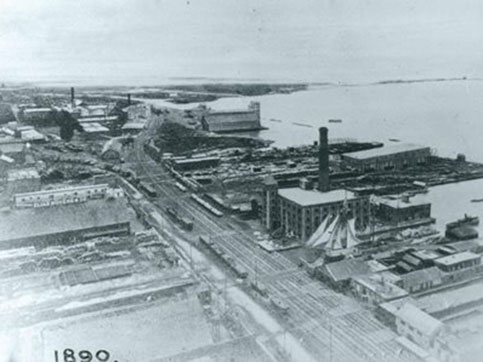The TPA’s Role in Shaping Toronto’s Waterfront

Toronto’s South Core and waterfront in 1890 prior to development by the Toronto Harbour Commissioners
Toronto’s South Core is home to business headquarters, a thriving entertainment district and some of the most rapid development in North America today. It’s also a major transportation hub, with Union Station, Billy Bishop Toronto City Airport and Toronto’s Harbour providing access for both people and products into the heart of the City, by rail, plane and boat.
However, the South Core and waterfront weren’t always flourishing neighbourhoods– more than 100 years ago, much of the area was covered by swamp land. Since that time, and its creation by Parliament in 1911 as the then Toronto Harbour Commissioners, the Toronto Port Authority (TPA) has played a significant role in shaping the waterfront into what it is today.
The original purpose of the TPA (then known as the Toronto Harbour Commissioners) was to oversee the development of the waterfront, involving the addition of more than 2,000 acres of land spanning from the mouth of the Humber River to Ashbridges Bay. The TPA had three important duties:
1) Create a modern port and harbourfront
2) Develop recreational land for use of the people of Toronto
3) Create and develop industrial and commercial property
The TPA began creating the waterfront with the “1912 Plan,” part of which involved transforming swamp lands at the mouth of the Don River into dry lands. To accomplish this, the TPA drained 1,000 acres of swamp and filled the gap with earthto create what are now the Port Lands. The creation of the Port Lands was beneficial to the City for several reasons: It made room for new factories and industrial development; eased the movement of ships through the harbour; and improved public health, as it helped to reduce contamination of the City’s drinking water caused by accumulation of waste and sewage carried by the Don River into the swamp’s waters. Today, this area is home to the Leslie Street Spit (Tommy Thompson Park) and the Outer Harbour Marina, increasingly popular destinations for recreation and relaxation in Toronto.
In addition to creating the Port Lands, the TPA was also responsible for many important developments in the South Core and along the waterfront, such as:
- Building the Quays that extend into Toronto’s Harbour, now known as Corus Quay, HTO Park Quay, Eireann (formerly Bathurst) Quay, and others;
- Building Toronto’s first civil air harbor and seaplane base;
- Creating Sunnyside Park and amusement park;
- Developing Billy Bishop Toronto City Airport;
- Installing basic infrastructure (sewers, pipes, etc.) in the lands created;
- Creating the Leslie Street Spit; and,
- Enlarging the Toronto Islands to increase recreational space for Torontonians.
Today, the TPA continues to build and steward a dynamic, sustainable and thriving waterfront. To learn more about the history of the TPA, click here.